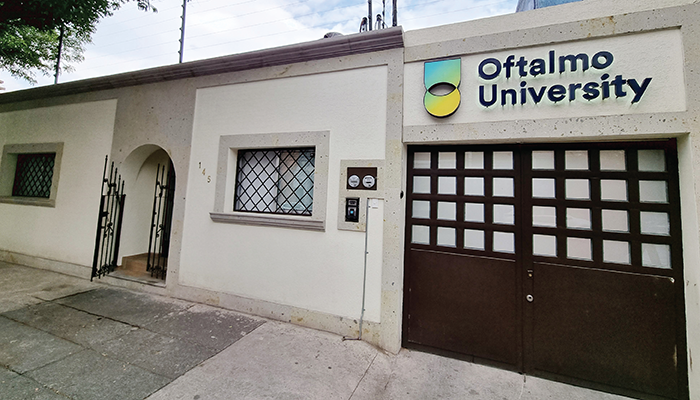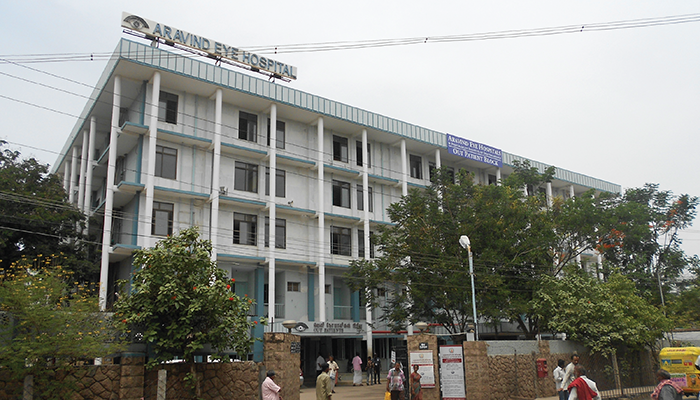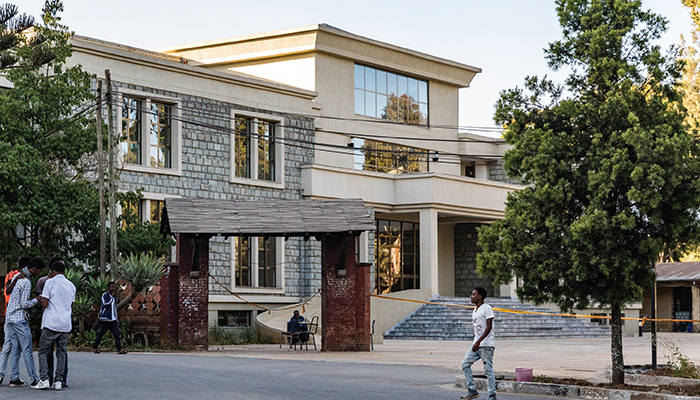
Global ophthalmology is in the midst of an impressive pincer movement – on one flank, a shortage of ophthalmologists; on the other, an aging, expanding world population and a concomitant rise in age-related eye diseases. One response to this overwhelming maneuver is ophthalmology education that directly addresses widespread unmet needs and regional gaps in training.

Click below to read about efforts by our sponsors Roche and Rayner to train the eye care professionals of the future.
The Ophthalmologist is proud to launch an annual initiative that recognizes the global educational impact of the institutions and programs that are leading the way in tackling health inequity. Our first Global Education Impact feature recognizes six institutions – a tour of the world from Mexico City to the Indian subcontinent, by way of long-established, state-of-the-art facilities in the US and UK. Find out how they are fostering cutting-edge technology, pairing local students and practitioners with expert mentors, and rolling out upskilling initiatives to the far corners of the world. Explore how they are focused on bringing new generations of ophthalmologists from diverse backgrounds and cultures into the profession, while facilitating treatment in the world’s poorest areas.
Whatever their approach, all six institutions are united by the same ultimate aim: to ensure that everyone has access to quality eye care, regardless of location, age, or socioeconomic status.
Oftalmo University
Location: Mexico City
Established: 2017
Focus: Latin America (but with international ambitions)
Still in its relative infancy, Oftalmo University (OU) was set up in 2017 in Mexico City by a group of dedicated ophthalmologists who wanted to empower young eye care professionals to further their careers and become the best versions of themselves. “The inspiration behind the inception of Oftalmo University was to democratize access to high-quality ophthalmology education,” says co-founder and CEO of the university, Ivo Ferreira Ríos. “We identified a pronounced void in specialized training, particularly in clinical and surgical subspecialties within ophthalmology, where access was inequitably distributed.” By collaborating closely with leading training centers, OU serves as a “trailblazing entity” in the landscape of ophthalmological education, adds Ferreira Ríos. “We're not just an add-on; we're a disruptive center designed to revolutionize how ophthalmological education is delivered and accessed.”
With this “pronounced void” clearly identified by the team, the OU leaders are now focused on myriad unmet needs within ophthalmological education, namely: accessibility, affordability, technological Integration, hands-on experience, interdisciplinary training, cultural competency, continuous learning, research opportunities, global perspectives, and patient communication. Andres Benatti, a cornea and refractive surgeon with a specialism in LASIK surgery and a co-founder of the university, believes that addressing these needs is “critical for preparing a new generation of ophthalmologists, who are not only skilled but are also adaptable, empathetic, and ready to meet the challenges of a rapidly evolving healthcare landscape.”
Oliver Garcia Yañez, an ophthalmology mentor at the university, explains, “We have trained over 1,000 ophthalmologists from 16 predominantly Latin American nationalities, where universal learning opportunities for cataract surgery are limited and the need for surgery is high. The plan is to further expand this teaching strategy worldwide, promoting the benefits of this link that makes it easier to learn cataract surgery.” To facilitate communication and the exchange of information, the university offers all of its courses in English. It also provides transportation, airport accommodation, and campus facilities to its international students, smoothing the path for those arriving in a new country for the first time. “We also adapt to the student’s educational level and the procedures followed in their home country,” says Yañez. “These courses are fully personalized with the aim of ensuring that, when students return to their home country, they feel the benefit of applying what they have learned.”
Ferreira Ríos adds that the university ensures accessibility to its education programs for individuals from diverse backgrounds and regions, including those with limited resources, through partnerships with both local and international ophthalmological companies.
The university recognizes technology as an essential component to its practices. “At OU, leveraging technology is not just an option, it’s integral to our mission of democratizing ophthalmology education,” says Lisandro Carnielli, an AI consultant and OU’s Chief Technology Officer. Virtual learning environments, simulation technologies, social media outreach, and data analytics all substantially inform how the university teaches its students. “By incorporating these technologies, we’re not only staying ahead of the curve but also ensuring that our students are equipped with the skills and knowledge they need to excel in the ever-evolving field of ophthalmology,” she says. “We want to seize technology’s tremendous potential to redefine how ophthalmology is taught and practiced. Through innovations like artificial intelligence, virtual reality, and telemedicine, we aim to set new standards in personalized, interactive, and hands-on learning. These aren’t just enhancements; they are disruptive methodologies designed to revolutionize ophthalmology education from the ground up.”
Setting their sights into the future, the university’s primary ambition is clear, says Andres Benatti: “To be a global catalyst for change in ophthalmology education, exponentially magnifying our impact far beyond the traditional scope of academia. At the core of this transformative vision is our commitment to scaling our reach internationally. We’re not
just about creating competent ophthalmologists; we’re about developing community leaders in eye care who will transform local eye care across the globe.”
As Oftalmo University continues to evolve, its focus is four-fold: global reach, technological prowess, disruptive educational methodologies, and, above all, community impact, says Carnielli. “We’re not merely expanding; we’re amplifying our influence, converting each student’s success into community transformations. In this way, the impact of Oftalmo University is exponential – not just changing individual lives but reshaping entire communities through better eye care. And this, we believe, is the true measure of our future success.”

International Centre for Eye Health
Location: London School of Hygiene & Tropical Medicine, UK
Established: 1980
Focus: International
Established in 1980 by Moorfields Hospital ophthalmology professor, Barrie R. Jones, as a way to address the global challenges of eye care, the International Centre for Eye Health (ICEH) recently celebrated 40 years of work in ophthalmological research, education, capacity strengthening, and technology. A collaborative network of clinicians, health economists, public health specialists, epidemiologists, statisticians, and evidence synthesis specialists, ICEH is based at the London School of Hygiene & Tropical Medicine (LSHTM).
Despite many fluctuations in the medical landscape since its establishment, ICEH’s mission to improve eye health in low and middle income countries (LMICs) has remained its highest priority. “Very early on, it was clear that much more was needed in terms of education for public health in eye care,” notes Andrew Bastawrous, ICEH Professor and co-founder of award-winning health social enterprise Peek Vision. “Equipping ophthalmologists and other eye care professionals with the skills to appropriately plan, conduct, and evaluate community programs is an essential part of improving eye health globally.” To achieve this aim, the center works through various partnerships, particularly within LMICs, and has a large network of research collaborators and alumni, comprising many eye health leaders across the globe.
ICEH is now widely viewed as a leading center for education and training in global eye health. In collaboration with LSHTM, it runs a Master’s (MSc) degree in Public Health for Eye Care, which enables ophthalmic professionals to develop evidence-based public health approaches towards reducing blindness and visual disability at local, national, and international levels. The center also manages an annual one-week short course aimed at ophthalmologists, optometrists, ophthalmic nurses, and program managers, introducing them to strategies to reduce blindness and visual impairments. ICEH also offers free online courses covering a range of topics, including glaucoma, retinopathy of prematurity, and diabetic eye disease. “Course content is designed for people working in all contexts, with an emphasis on LMIC settings; case studies used within our courses include examples from all regions, including low-resource areas,” explains Bastawrous. “Our online courses have been accessed by over 40,000 people from 180 countries and territories, and our intensive MSc course has been taken by more than 750 eye health professionals from 100 countries.”
ICEH alumni are already having a huge global impact, with many going on to hold global leadership positions in eye health. Some notable names are Jacquelyn O’Banion (Associate Professor and Director of Global Ophthalmology at Emory University, US), Oteri Okolo (National Eye Health Coordinator for the Federal Ministry of Health, Nigeria), and Shalinder Sabherwal (Director Public Health and Projects, Shroff's Charity Eye Hospital network, India).
ICEH prides itself in its engagement with academic research. Every three months, it publishes the free, peer-reviewed Community Eye Health Journal (CEHJ), aimed at eye care professionals working in some of the hardest-to-reach LMICs. CEHJ is available as an app and in print, is produced in four different languages (English, French, Chinese, and Spanish), and sent out to over 20,000 readers worldwide.
The aforementioned Peek Vision also plays a significant role in ICEH’s global work. Bastawrous explains: “Peek began life more than a decade ago as part of my PhD research project in rural Kenya with ICEH.” Since spinning out in 2015, it continues to collaborate with ICEH on research, teaching, and dissemination of information. Current projects include the development of the Rapid Assessment of Avoidable Blindness (RAAB), aimed at driving action to prevent avoidable vision loss, and the School Eye Health Rapid Assessment tool (SEHRA) for improving school eye health programs.
ICEH’s main goal remains reaching as many ophthalmologists and other eye health professions as possible, attempting to embed public health teaching into international ophthalmic education. “We intend to expand our online course portfolio to include additional topics and languages, and train more leaders in research globally,” says Bastawrous. “We are always looking for exceptional students to join our MSc program. The benefits of the course for ophthalmologists in any country are vast, opening up new areas of practice and providing a global perspective on eye health, leading to extremely rewarding careers.”

The University of Colorado School of Medicine Department of Ophthalmology
Location: Denver, US
Established: 1883
Focus: International
The University of Colorado (CU) School of Medicine is consistently ranked as a leading medical school in the US; for example, placing eighth for primary care and 26th for research (out of 123 US institutions) in 2023’s Best Medical School rankings compiled by US News & World Report (May 11, 2023). This was the sixth time CU made the top 10 for primary care in Best Medical School rankings in the last eight years.
The School of Medicine’s Department of Ophthalmology – established in 1883 – is held in similarly high esteem. The University of Colorado Health Eye Center is based at Sue Anschutz-Rodgers Eye Center, one of the largest state-of-the-art facilities in the US, and the department’s 11 full-time faculty teaching members are prominent in research and teaching activities on an international scale.
Among these eminent educators is Power Lister Malik Y. Kahook, Professor of Ophthalmology, Slater Family Endowed Chair in Ophthalmology, Chief of the Glaucoma Service, and Co-director of the Glaucoma Fellowship at CU. Kahook is a noted innovator and inventor, with more than 40 patents granted, many of which have been licensed by companies for development and commercialization. Accordingly, he is heavily involved in promoting the use of cutting-edge technology in training at CU; for example, using AI for diagnostics and robotic-assisted surgery. “Our department has a leading AI team – headed by Jayashree Kalpathy-Cramer, Chief of Artificial Medical Intelligence in Ophthalmology – that is active in creating tools that can be used for the early diagnosis of eye diseases, as well as assist in longitudinal assessment to better treat these problems,” he says.
The development of advanced simulators and virtual reality platforms to enhance ophthalmologists’ surgical skills in complex procedures is another way in which CU is promoting advanced technology. “Several of our faculty members are involved in testing and improving both software and hardware to address these needs,” says Kahook. And this technology is driving projects that are focused on the needs of low- and middle- income countries (LMICs), and how their access to solutions might be “enhanced with thoughtfulness” at the onset of each specific project.
Kahook is central to CU’s ties with Orbis International – the global NPO focused on prevention and treatment of avoidable blindness through training, education, and advocacy, especially in LMICs – and Sidra Tree Foundation, which financially supports the efforts of NGOs focused on eye care. Serving on the boards of both Orbis and Sida Tree (and volunteering with the Orbis Flying Eye Hospital since 2018), he explains that CU’s ophthalmology department is supporting and facilitating these nonprofits’ efforts in teaching and supporting ophthalmic and optometric clinicians around the globe. “Many regions lack access to quality ophthalmology education and training programs, especially in low-resource areas,” he explains. “We are attempting to address this by supporting online courses and telemedicine-based training to reach underserved populations.” Kahook himself has been involved in some of the early testing of Orbis’ and Fundamental VR’s training simulator, with a view to supplying global trainees with lower-cost VR training systems. This particular platform is in its early stages, he explains, but should help “upskill trainees before and after they perform new procedures” and get them “up and running” more quickly and more safely.
Kahook and CU’s support for training opportunities around the world goes beyond the promotion of cutting-edge technology. Fostering mentorship programs and global networks to connect experienced ophthalmologists with trainees is something Kahook is passionate about. He has mentored several visiting fellows through CU and Orbis and programs, such as the International Ophthalmological Fellowship Foundation. “Our past fellows have gone on to be leaders in their fields and have also engaged in teaching the next generation of learners in their respective countries,” he says. Expanding subspecialty training opportunities, such as pediatric ophthalmology and retina specialties, to meet diverse patient needs is also a driver of CU’s global education impact. “Our faculty, from neuro-ophthalmology to glaucoma, currently support multiple visiting fellows each year and also visit their home institutions to continue dialogue and foster a lasting relationship of learning.”

Aravind Eye Care System
Location: India
Established: 1976
Focus: India
Since its inception in 1976, the Aravind Eye Care System has placed much emphasis on ensuring that all patients are afforded the same quality of eye care, regardless of socioeconomic status. This ethos is also embedded into Aravind’s training programs, which cater to all levels of ophthalmic personnel, including ophthalmologists, technicians, opticians, clinical assistants, outreach coordinators, and healthcare managers.
Aravind’s mission is to eliminate needless blindness by providing large-volume, high-quality and affordable care. “Well-trained manpower is extremely important to achieve this mission,” says R. Rathinam, Principal of the Postgraduate Institute of Ophthalmology at Aravind Eye Hospital, Madurai. The Institute offers postgraduate degree and diploma courses, fellowship programs, paramedical training and courses in administration and hospital management. Trainees at the Institute have the chance to participate in hands-on training, use state-of-the-art technology, tap into worldwide eye care resources, and interact with peers from around the world.
Aravind’s commitment to tackling eye health on a large scale through education and training was evidenced when it joined forces with the Business Call to Action in 2012 to train 750 healthcare workers through an online system. The aim was to increase the number of yearly eye surgeries in India. By 2015, the number of eye surgeries performed each year had increased by 15 percent, from 350,000 to 400,000. Of these surgeries, 300,000 were provided at low or no cost to the country’s most impoverished people (bit.ly/3Ryk7Xn). As part of the program, Avarind pledged to train 650 women from rural communities as certified mid-level ophthalmic professionals (MLOPs) to “make ophthalmologists more productive” (bit.ly/3ZtMCHI). MLOPs, Aravind’s paramedic staff, are mostly young women, typically with a secondary education, from poor families in rural India. They receive two years of in-house training from senior paramedic staff to become nurses, technicians, and counselors, taking paramedic positions in Aravind’s hospitals and clinics. As of 2016, Aravind employed 2,200 MLOPs and 900 were in training.
Talking in 2021 about its involvement in eye care research and hospital capacity-building around the world, Dhivya Ramsamy, senior faculty member at Aravind, explained how its management consulting to other centers and hospitals had moved online since the pandemic, making them more convenient and accessible (bit.ly/3POIqOD). “We have been able to see the hospitals increase volume, improve their data management, and serve more patients,” Ramsamy explained. “One organization we worked with wanted to increase its surgical acceptance rate – the percentage who actually go through with cataract surgery. We strengthened their counseling and service design. For the entire cohort, we saw a 27 percent increase in surgeries. They got a 100-fold return on their investment in training.”

Global Ophthalmology Fellowship, Emory Eye Center
Location: Georgia, US
Established: 2011
Focus: Ethiopia
The Global Ophthalmology (GO)-Emery fellowship was established by Emory Eye Center in 2011. Fellows are given the opportunity to provide clinical care in Ethiopia’s Addis Ababa and Menelik hospitals, as well as other outreach sights throughout Ethiopia. As part of the fellowship, and in line with delivering international care, fellows are expected to complete a research project aimed at improving eyecare in vulnerable populations.
During their time in Ethiopia, fellows are exposed to public health approaches to eye care (such as the control and elimination of trachoma and onchocerciasis), as well as the management of cataract blindness with partner organizations. Additionally, they have the opportunity to get involved in public health campaigns, mass drug administrations, and cataract campaigns. This first-hand experience offers fellows a unique insight into the challenges of delivering eye care in low income countries whilst also developing their skill sets. The GO-Emory fellowship is unique in that it can be tailored for each individual fellow.
Last year, GO-E received a three-year, $90,000 grant from Vision2020 LINK USA to continue training ophthalmology residents from Ethiopia's Addis Ababa University (AAU), while bolstering much-needed screenings for retinopathy of prematurity (ROP) and diabetic retinopathy (DR). GO-E's co-director, Jacquelyn O'Banion, said, “The idea is to improve our outreach to underserved populations in Ethiopia while, at the same time, increasing the subspecialty expertise of the locally trained ophthalmologists. (bit.ly/3EPkhSJ). Now that the COVID-19 pandemic is beginning to retreat, we are looking forward to a more robust exchange of physicians between our two countries.”
She added, “Across the world, there are so many instances where treatable eye conditions deteriorate into blindness – sometimes because there simply isn’t an ophthalmologist with the proper training to deliver it. When GO-E is able to train our colleagues from low-resourced countries like Ethiopia, we can stave off this trend – now, and in the future.”
Although its activities are focused in Ethiopia, GO-E offers other international opportunities to encourage specific interests and career goals. The program also works with other international eye care organizations, such as the Himalayan Cataract Project, Orbis, the Carter Center, and Sightsavers International.

Moorfields Education, Moorfields Eye Hospital and the University College London Institute of Ophthalmology
Location: London, UK
Established: 2014
Focus: International
Since its founding in 1804, Moorfields has established a global reputation for delivering excellence in eye care, and continues to lead the charge when it comes to ophthalmic training. Of particular note is Moorfields Education, led by Michèle Russell, Joint Director of Education at both Moorfields Eye Hospital and the University College London (UCL) Institute of Ophthalmology. Moorfields Education is a collaboration with UCL that provides visionary education for clinical ophthalmic leaders through pioneering courses and programs, as well as offering both medical electives and fellowships.
Combining the UCL Institute of Ophthalmology’s scientific expertise with Moorfields Hospital’s work environment, Moorfields Education courses engage all stakeholders in the eye care sector, as well as the patients themselves, to consider the real-world practices that are making a difference to patients. The courses offer the opportunity to gain the necessary skills and training through the combined knowledge and expertise of hundreds of world-renowned leaders in vision and eye health.
Alongside learning from some of the biggest names in ophthalmology, program participants are afforded valuable practical experience with patients. Gus Gazzard, Moorfields’ Director of Glaucoma, explained, “One of our great strengths is that not only are we very experienced with online and lecture-based teaching, but we are able to blend that with teaching with real patients. We have a large number of patients who are very keen to come back in, share their experiences, and to help train the next generation of clinicians.”
Although situated in London, Moorfields’ commitment to educating eye care professionals is not limited by borders. In tandem with the online courses that can be accessed and completed from anywhere, Moorfields opens its doors to international trainees and students. As Consultant Ophthalmologist and Professor of Retinal Neuroscience Omar Mahroo puts it, “One of the reasons I find teaching [at Moorfields] so fulfilling is that we are fortunate to have students and trainees from all across the world. We feel that, through our teaching and our activities, we are not just benefiting the patients we manage but patients globally.”
Beyond the substantive internal education and training that Moorfields undertakes, the Moorfields Eye Charity offers funding to projects to teach and build up the next generation of world-leading eye researchers and clinicians. Although the institution is one with an incredible history, Moorfields’ focus is firmly on the future – providing the patients of tomorrow with the best possible eye care and investing in the training of the experts needed to make it happen.

